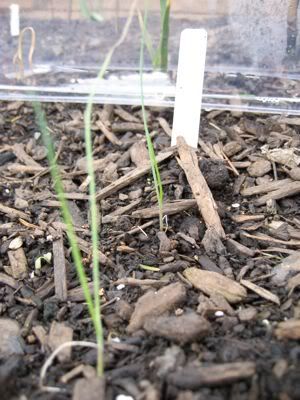Allium ampeloprasum: Leek cultivation dates back hundreds of years to southern Europe. Today the leek serves as an excellent substitute for onions and can be grown in protected gardens well into the fall.
CULTURE: Leeks are a cool-season biennial grown as an annual. They are well worth the effort because they are frost hardy and can supply the gardener with fresh onions all winter and well into spring. They thrive in well composted, well worked, and well drained soil. Leeks can be started as transplants or direct sown in the garden if you have optimum soil conditions. Transplants will yield larger plants by autumn.
FOR TRANSPLANTS: Begin 8-10 weeks before your last frost. Sow 4 seeds per inch, 1/4-1/2 inch deep in rows 3 inches apart in your tray. Optimum soil temperature for germination: 55-75°F. Days to emergence: 8-16 days. Thin seedlings to 1/2 inch apart in the row. For stockier plants, keep the tops trimmed to 3 inches. Transplant into the garden after the threat of frost and the soil can be worked to a depth of 8-10 inches. Dig a trench 6-8 inches deep and wide. Each row should be 12-18 inches apart. Work in 1/4-1/2 cup of our complete fertilizer per 5 row feet. Place seedlings 4-5 inches apart in the bottom of the trench. Blanch to increase the length of white stem by gradually filling in the trench as the leeks grow.
DIRECT SEEDING: After your last frost, direct sow seeds 1/4-1/2 inch deep in rows 12-18 inches apart. Cover with vermiculite or sifted compost. Thin plants to 4-5 inches apart.
HARVEST: Dig anytime the leeks are 1/2 inch in diameter or larger. Can be used raw or cooked. Store at 33°F and 65% relative humidity.
INSECTS/PESTS: Seldom a problem.
DISEASE: Very resistant.
SEED SPECS: Minimum germination standard: 70%. Usual seed life: 1 year. Days to maturity are calculated from date of transplant. Approximately 175 seeds per 1/2 gram, about 350 seeds per gram; 14 grams per 1/2 ounce. A sampler will sow 25 feet.
----------
WHEN TO PLANT: I plant the seeds in flats in February, and thin the seedlings to stand no closer then 1" apart in the flat. Plant them out in April or May or direct seed in the ground in April, preferably in a nursery bed to save space. Leeks need a long growing season but will accept a variety of growing conditions. Where winters are mild, leeks can be planted in the fall for a winter crop.
HOW TO PLANT: Plant the seedlings in a trench 6" wide x 6" deep. When the plants are 6-8" high, gradually hoe find soil from the sides of the trench to fill the space. Do this every three weeks or so, adding an inch of soil to the trench each time. Always keep the soil level at or just below the point where the leaves diverge from the stem. Leeks are biennials, and those that take longer to mature will usually keep well into winter if hilled up with soil or mulched.
GROWING CONDITIONS: They do respond well to plenty of humus and steady moisture and their extensive roots appreciate deeply dug soil. Leeks left in the ground over winter will form corms - tiny bulbs - around the base in late spring. You can plant these corms for an easy second year crop of this tasty vegetable.
----------
PURCHASED: 1/8g from Territorial Seed Co. Jan '09. $3.45
STARTED SEED: 2/5/09, 9 pm - one batch with heating mat (82° - consistent) one without (72° / next morning 62°). The unheated tray showed its first sprout on 2/11 - 6 days!
HARDENED OFF: 3/15/09: One hour in the cold frame.
TRANSPLANTED IN GARDEN:
DISEASE ISSUES:
INSECT ISSUES:
HARVEST YEILD & DURATION:
OTHER NOTES:
03/02/09

03/16/09

03/30/09

No comments:
Post a Comment